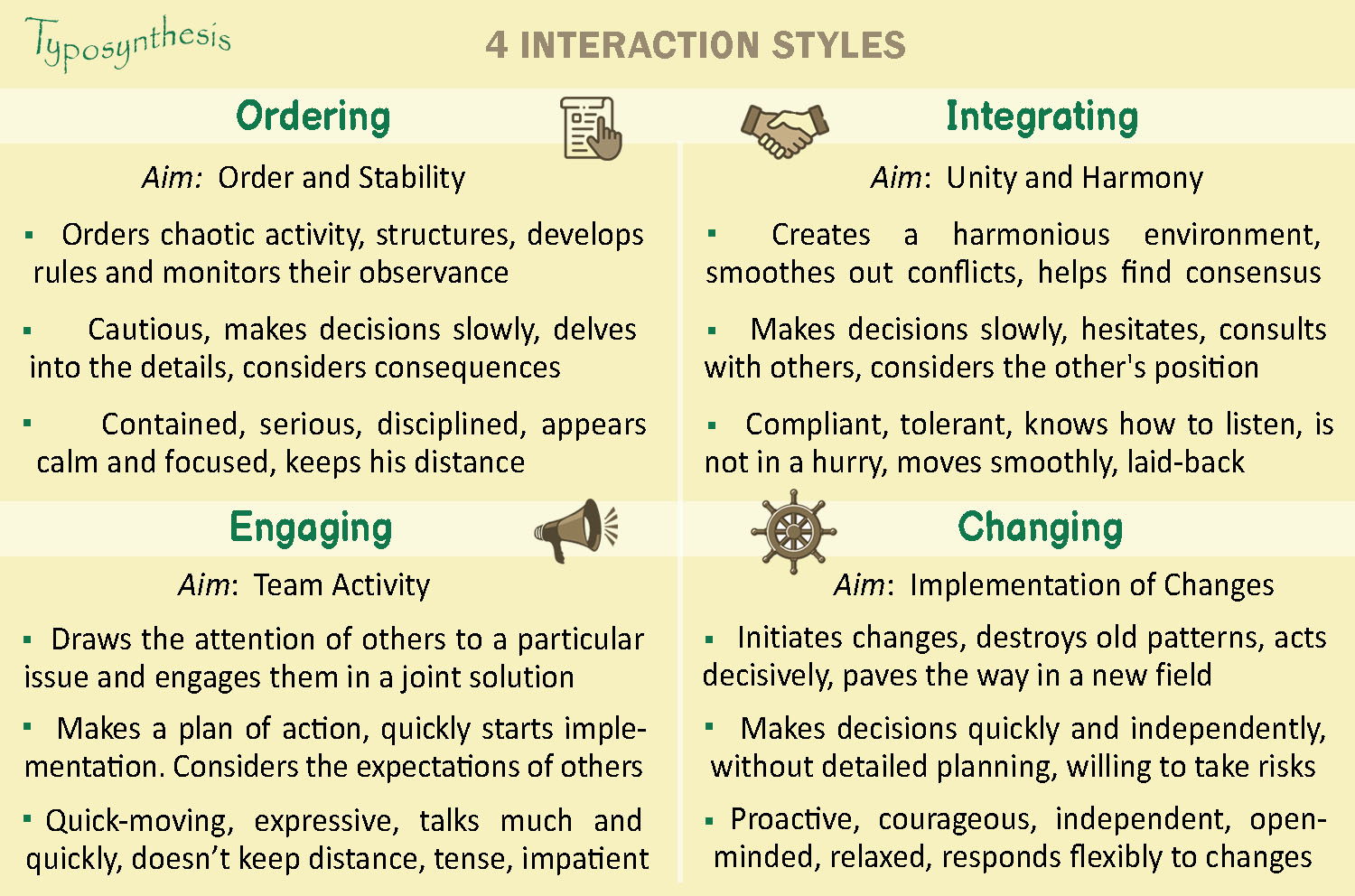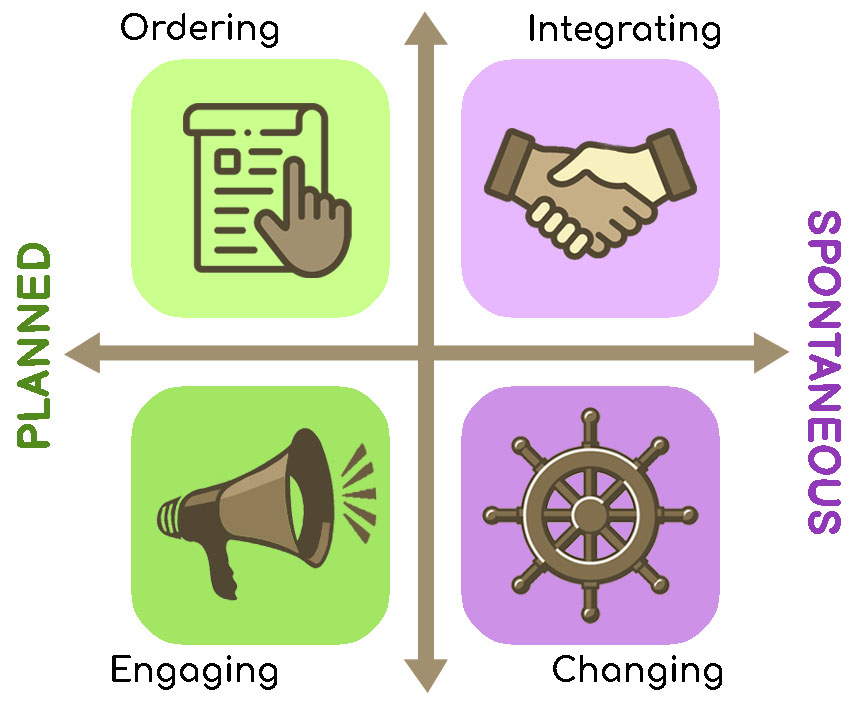FOUR INTERACTION STYLES
Since childhood, we all have certain patterns of behavior, certain preferences and, in general, a certain attitude towards life. We all express ourselves in different ways and influence others in different ways. Often we cannot understand the behavior of other people, and they cannot understand ours. Moreover, sometimes we cannot understand what is driving our own behavior.
In order for individual characteristics to be used with benefit, and not to become a barrier in relationships between people, it is worth understanding what goals, motivations and beliefs underlie people's behavior. Understanding your own interaction style and the style of other people contributes to more effective communication and helps to avoid many misunderstandings.
There are four interaction styles
Different styles are characterized by different aims, and different strategies are applied to achieve these aims.
• Ordering style.  People with the Ordering style are driven to ensure order and stability. They order chaotic activity, structure, create a system, develop rules and monitor their observance.
People with the Ordering style are driven to ensure order and stability. They order chaotic activity, structure, create a system, develop rules and monitor their observance.
They usually look serious and considered, keep psychological distance in communication, often retain impassible countenance.
• Engaging style.  People with the Engaging style are driven to organize collaborative activities. They know how to draw others' attention to a particular issue and engage them in a joint discussion and activity. They can easily interact with strangers and they are actively using social networks.
People with the Engaging style are driven to organize collaborative activities. They know how to draw others' attention to a particular issue and engage them in a joint discussion and activity. They can easily interact with strangers and they are actively using social networks.
Engagers are usually quick-moving, impatient, tense, and expressive, they talk much and quickly and don’t keep a distance in communication.
• Changing style.  People with the Changing style are driven to implement changes. They destroy old systems and patterns, initiate changes, act decisively and confidently, quickly orient themselves in a new situation, pave the way in a new field.
People with the Changing style are driven to implement changes. They destroy old systems and patterns, initiate changes, act decisively and confidently, quickly orient themselves in a new situation, pave the way in a new field.
They are proactive, independent, courageous, energetic, creative, open-minded, they have a laid-back manner and flexibly react to changes.
• Integrating style.  People with the Integrating style are driven to create unity and harmony. They smooth out conflicts, help find consensus, create a harmonious environment. They show diplomacy, avoid being direct and categorical in their statements, so as not to offend anyone.
People with the Integrating style are driven to create unity and harmony. They smooth out conflicts, help find consensus, create a harmonious environment. They show diplomacy, avoid being direct and categorical in their statements, so as not to offend anyone.
They are pliant, accommodating and tolerant in nature, condescending to other people’s weaknesses, respecting the personal space of others, they are great listeners. They are not in a hurry, move smoothly, appear relaxed.
Each style is associated with a specific way of making decisions.
Integrating – consults with others, tries to take into account all factors and opinions, hesitates, delaying the decision for as long as possible; waiting for support or boost from others.
Changing – makes decisions quickly and independently, without detailed planning and deliberation, takes a non-standard approach in solving problems, willing to take risks, easily changes decisions when circumstances change.
Engaging – develops a clear plan of action before acting. Focused on achieving rapid results, can't relax until the job is completed. Can adjust plans according to the expectations of others.
Ordering – carefully consider one’s decision, gathering additional information, delving into details, ponders possible consequences. Moves towards the goal slowly and methodically. Usually does not change one’s decisions.
Here’s an example of how people of different styles behave on vacation:
Lily : Makes a detailed itinerary months in advance. Wants to spend her vacation with benefit: go to the museum or bookstore. On each excursion corrects the guide, if he does not speak accurately enough, which irritates the latter.
Henry : Suggests a lot of options of vacation and articulates these to the people around. Plans the route and coordinates the actions of the participants. During the holidays engages everybody in joint activity: cooking, playing, hiking. Prevents Lily from quietly reading the book.
Grace : Changes plans at the last moment. Doesn’t care what anyone thinks. Throws spontaneous vacation with 8 people she just met. Refuses to sleep because there is so much to do!
Teddy : Doesn’t go where he really wants to because he can't say no to Grace. Enjoys nature in a quiet place alone. Sometimes participates in Grace’s crazy activities, tries to create a harmonious environment in the company and smooth out conflicts.
Try to identify the interaction style of each of them.
Attitude towards rules and restrictions
Attitude to rules and restrictions is closely related to planned and spontaneous approaches to life. The more a planned approach prevails in a person, the more important the rules are for him, the easier he perceives restrictions. The more a spontaneous approach prevails in a person, the less he is inclined to follow rules and limit himself in anything.
People with Ordering and Engaging style have a planned approach to life, they tend to keep agreements, easily tune in to established rules and procedures, abide by them, and expect others to do the same. Rules, laws and order provide them with a sense of security and stability.
People with Changing and Integrating style have a spontaneous approach to life, they try not to bind themselves with obligations and agreements, value a sense of freedom and the ability to act spontaneously, rules and restrictions limit their creativity.
Rules and reasonable restrictions are the most appreciated by people with a predominant Ordering style, while people who like rules the least are those with a predominant Changing style.
Ordering: Shares the view that the rules and laws are the same for everyone. Can establish the rules himself and ensure that others follow them. Believes we should stop at red lights when there is no other traffic, signal when turning even if there's no one to signal to. Ordering style is prone to self-discipline and limitation of one's needs, saving and asceticism.
Engaging: Needs certain rules and a structured environment for a sense of stability, but may break the rules if it does not cause a negative reaction from others. Openly expresses disagreement with unclear or ridiculous restrictions and rules.
Integrating: Rules are not important to him. Follows established rules so as not to be rude to anyone. Easily breaks rules when no one is looking. Never openly opposes anything. If he doesn't want to follow the rules, he passively resists and discreetly sabotages.
Changing: Perceives rules and obligations as restriction of freedom, easily violates them, reacts negatively to any restrictions. There are no authorities for him, he is not swayed by the opinion of others, does not succumb to the pressure of social conventions or patterns and is prone to open dissent and rebellion.
We use different styles in different circumstances. A person can show one style at home, a second with friends, and a third at work.
The nature of the job strongly influences the style of interaction. For example, for such a monotonous job as accounting or programming, the Ordering style is most suitable, while for such dynamic job as a firefighter or actor, the Changing style is most suitable. A person with an Ordering style would find it difficult to work as a firefighter, and for a person with a Changing style it would be a real punishment to work as an accountant.
People can change their interaction style depending on the situation. However, everyone has one’s own natural style in which he or she feels most comfortable and resourceful. Other styles may be too energy-consuming for a person, especially when he is forced to use a style unusual for him for a long time.
Interaction styles in different countries
A person's interaction style is also influenced by the interaction style of the country in which he lives. People from different countries have different interaction styles.
This is how Richard Lewis describes the differences in behavior in his book “When Cultures Collide”:
“I was once in charge of an English language summer course in North Wales for adult students from three countries—Italy, Japan, and Finland. Intensive instruction was relieved by entertainment in the evenings and by day excursions to places of scenic or historical interest. We had scheduled a trip up Mount Snowdon on a particular Wednesday, but on the Tuesday evening it rained heavily. Around 10 o’clock that night, during the after-dinner dancing, a dozen or so Finns approached me and suggested that we cancel the excursion, as it would be no fun climbing the muddy slopes of Snowdon in heavy rain. I, of course, agreed and announced the cancellation.
Immediately I was surrounded by protesting Italians disputing the decision. Why cancel the trip—they had been looking forward to it (escape from lessons), they had paid for it in their all-inclusive fee, a little rain would not hurt anyone and what was the matter with the Finns anyway—weren’t they supposed to be tough people? A little embarrassed, I consulted the Japanese contingent. They were very, very nice. If the Italians wanted to go, they would go, too. If, on the other hand, we cancelled the trip they would be quite happy to stay in and take more lessons. The Italians jeered at the Finns, the Finns mumbled and scowled, and eventually, in order not to lose face, agreed they would go. The excursion was declared on. It rained torrentially all night and also while I took a quick breakfast. The bus was scheduled to leave at half past eight, and at twenty-five past, taking my umbrella in the downpour, I ran to the vehicle. Inside were 18 scowling Finns, 12 smiling Japanese, and no Italians. We left on time and had a terrible day. The rain never let up, we lunched in cloud at the summit, and returned covered in mud at 5 o’clock, in time to see the Italians taking tea and chocolate biscuits. They had sensibly stayed in bed. When the Finns asked them why, they said because it was raining...” (1)
In many countries, one style of interaction predominates over others.
The Ordering style is clearly expressed in Germany. It is also predominant in China.
An example of a somewhat hyperbolized Ordering style is the Amish settlements, where strong restrictions and ascetic lifestyle are practiced.
The Engaging style is characteristic of the United States.
The Integrating style is characteristic of Japan, and is also expressed in some Scandinavian countries.
The Changing style can be observed in countries such as Greece, India and Israel (2). The Changing style is also prevalent among Roma (gypsies).
No one style is better or worse than others. A certain style may be more efficient in a certain situation.
Knowing the typology allows not only to avoid many misunderstandings that can arise between people with different styles, but also to improve interaction with them.
* * *
1 - Richard D. Lewis. When Cultures Collide: Managing successfully across cultures. London 1996. Copyright Richard D Lewis. www.crossculture.com
2 - According to Dr. Adizes, the E role is prevalent in Greece, India and Israel. (Adizes, I. The ideal executive: why you cannot be one and what to do about it. 2004. Chapter 3: What Causes Mismanagement?) Typosynthesis connects the E role with the Changing style.
Original text in Ukrainian here >>>
Last updating 17.03.2024



 People with the Ordering style are driven to ensure order and stability. They order chaotic activity, structure, create a system, develop rules and monitor their observance.
People with the Ordering style are driven to ensure order and stability. They order chaotic activity, structure, create a system, develop rules and monitor their observance. People with the Engaging style are driven to organize collaborative activities. They know how to draw others' attention to a particular issue and engage them in a joint discussion and activity. They can easily interact with strangers and they are actively using social networks.
People with the Engaging style are driven to organize collaborative activities. They know how to draw others' attention to a particular issue and engage them in a joint discussion and activity. They can easily interact with strangers and they are actively using social networks. People with the Changing style are driven to implement changes. They destroy old systems and patterns, initiate changes, act decisively and confidently, quickly orient themselves in a new situation, pave the way in a new field.
People with the Changing style are driven to implement changes. They destroy old systems and patterns, initiate changes, act decisively and confidently, quickly orient themselves in a new situation, pave the way in a new field. People with the Integrating style are driven to create unity and harmony. They smooth out conflicts, help find consensus, create a harmonious environment. They show diplomacy, avoid being direct and categorical in their statements, so as not to offend anyone.
People with the Integrating style are driven to create unity and harmony. They smooth out conflicts, help find consensus, create a harmonious environment. They show diplomacy, avoid being direct and categorical in their statements, so as not to offend anyone.
